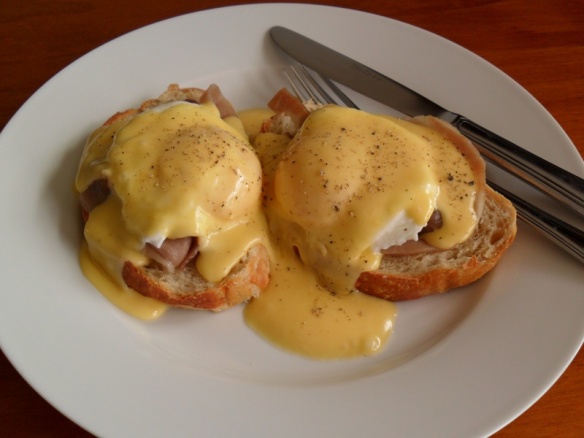Time saver: poached eggs, smothered in hollandaise sauce, could this be love?
 This is kind of a cheeky post-one-get-one-free deal, but I couldn’t let my Hollandaise Sauce post go without talking about Eggs Benedict in a bit more detail. I used to think of these as a cafe breakfast, but with a little bit of effort you can match or better what you’ll get at most cafes.
This is kind of a cheeky post-one-get-one-free deal, but I couldn’t let my Hollandaise Sauce post go without talking about Eggs Benedict in a bit more detail. I used to think of these as a cafe breakfast, but with a little bit of effort you can match or better what you’ll get at most cafes.
You can mix it up a bit but the key components tend to be: some sort of lightly-toasted bread base, a layer of filling (generally either bacon, ham, smoked salmon, or spinach), a poached egg, and then a generous serving of hollandaise sauce. I think traditionally a split English muffin is used for the base, in the photo I’m using toasted artisan bread, and lots of cafes in Auckland seem to use toasted Turkish bread.
The trickiest part to eggs benedict is probably the timing. You want to serve everything hot, so that means you need everything ready to go at the moment of assembly – eggs perfectly poached, bread lightly toasted, hollandaise rich and creamy, and your filling ready to go (easy if it’s smoked salmon, a bit trickier if doing bacon or spinach). There’s not really a lot you can do expect practice to get a a feel for it. If you prepare the hollandaise sauce beforehand (or, shock horror, use one from a pouch/jar) you can set it aside ready to go. You could also pre-poach the eggs, then just heat them when you’re ready to go (though in some ways this is more work).
For this recipe I’m going to refer you to previous recipes and tie them all together.
Eggs Benedict – serves 2 (makes 4 portions)
- 4 poached eggs (cooked as per my previous instructions)
- hollandaise sauce (quantities as per recipe – use 75g butter)
- 100g smoked salmon slices or middle bacon (trim rind) or ham or 50g spinach
- 4 pieces bread, e.g. English muffins, artisan bread, turkish bread
- freshly cracked black pepper, to taste
- Prepare the hollandaise sauce according to the recipe and set aside.
- Get bread ready for toasting, but don’t toast it yet.
- If using spinach you want it wilted, so I’d recommend steaming it gently, you should set this up now (i.e. heat the water, don’t actually put the spinach in the steamer yet). If using bacon (or ham and you want it heated) you should heat the frying pan now.
- Start poaching the eggs.
- Put the toast on – you don’t want it too crispy or it’s too hard to cut (but it shouldn’t be bread either).
- If using smoked salmon, relax, otherwise, quickly fry bacon/ham (should only take a couple of minutes). If using spinach you want it just wilted – do this in the steamer now.
- Remove the eggs from the water, drain and trim away any ragged edges. By this point your toast should be ready and you’re good to go.
- Assemble with toasted bread first, then a layer of your filling, then a poached egg, then a good 1-2 Tbsp hollandaise sauce on top (it should make a sort of smooth dome on top of the egg). Crack a little black pepper over the top and enjoy.


